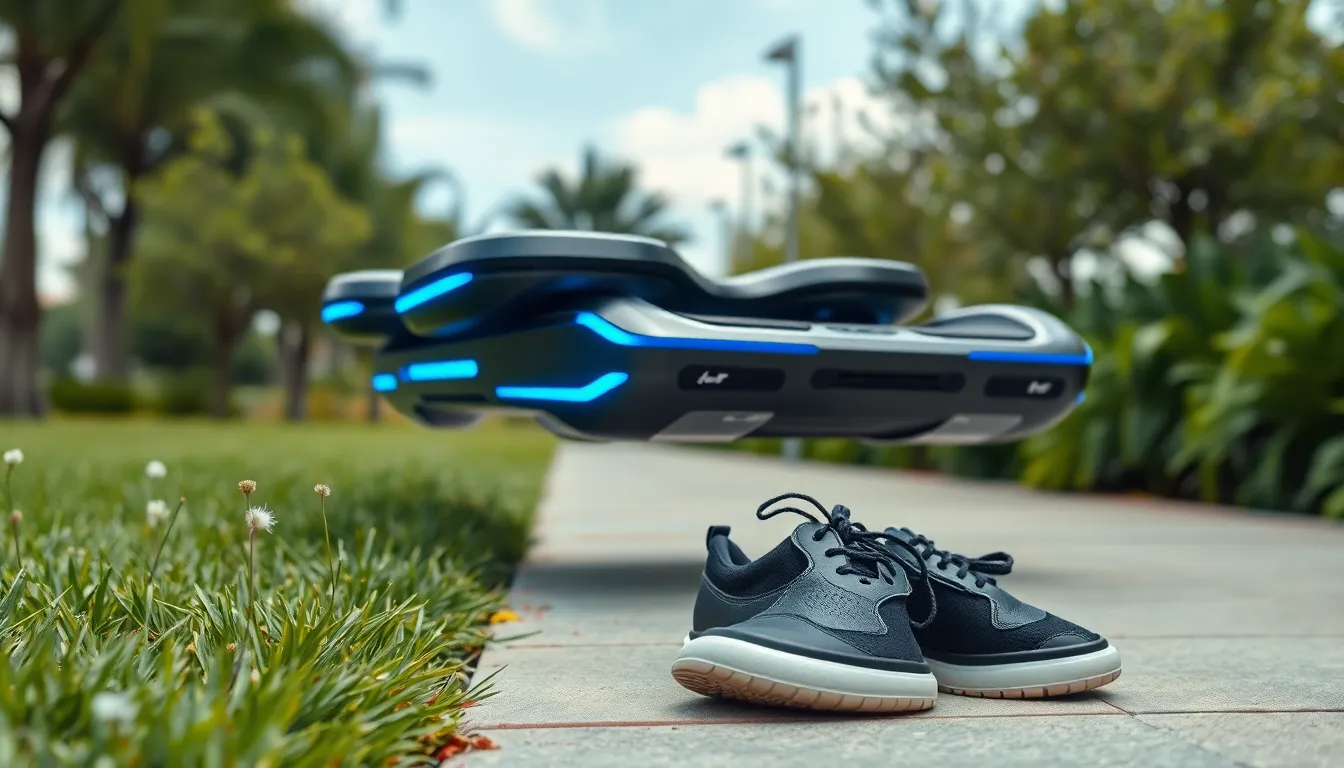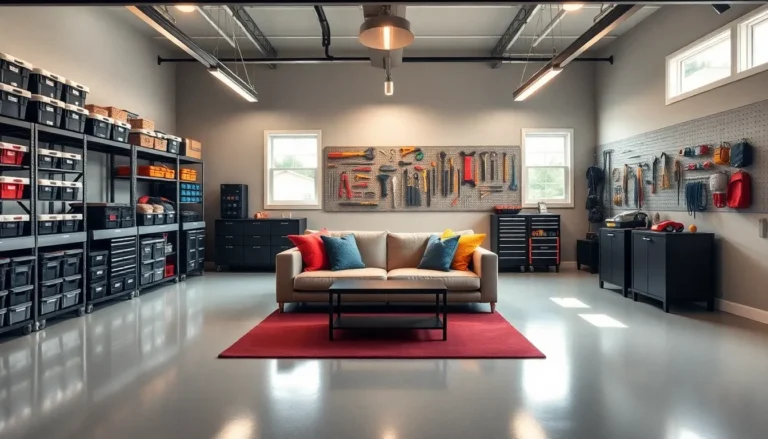Table of Contents
ToggleTime travel may still be a dream, but the predictions from Back to the Future have become a pop culture phenomenon. With flying cars and self-lacing shoes, the film’s vision of the future sparked imaginations and set the bar high for what’s to come. Who wouldn’t want to zoom around in a DeLorean while sporting a hoverboard?
Overview of Back to the Future Predictions
“Back to the Future” features several imaginative predictions that resonate with audiences. Flying cars appear prominently, showcasing a vision of advanced transportation. Self-lacing shoes captivate fashion enthusiasts and technophiles alike. Holographic advertisements fill the streets, transforming how brands engage with consumers. The movie’s depiction of virtual reality games highlights advancements in entertainment.
Robotic personal assistants are another notable aspect. They streamline daily tasks and enhance convenience for users. Instant food preparation, such as dehydrated pizzas, demonstrates advancements in culinary technology. Moreover, the film forecasts advancements in communication, like video calls that mimic today’s virtual meetings.
In addition, the timeline suggests significant societal shifts. Increased environmental awareness emerges through the use of clean energy in vehicles, reflecting real-world trends. Predictive technology, shown through devices that anticipate needs, raises questions about privacy and autonomy. The suggested use of smart homes aligns with today’s burgeoning smart home market.
Dates in “Back to the Future Part II,” specifically 2015, serve as a benchmark. Observers often reflect on how many features failed to materialize. Yet, some innovations, such as tablet-like devices and drones, did come to fruition. The film’s predictions offer a blend of hope and caution, sparking conversations about future possibilities.
These engaging concepts continue to inspire real-world innovations. Many creators reference the film in their design processes, aiming to bring its vision to life. The optimistic take on the future encourages a balance between imagination and reality in technology development.
Technological Innovations in the Franchise

The “Back to the Future” franchise vividly illustrates a world rich with technological innovations. Imagination drives these depictions, sparking interest in future advancements.
Hoverboards and Personal Transport
Hoverboards capture the essence of futuristic travel seen in the franchise. These devices float above ground, eliminating traditional wheels. While 2015 saw various attempts at hoverboard creation, none have achieved the film’s levitating design. Companies like Hendo Hover and Arx Pax have come close, producing prototypes that show promise. Furthermore, electric bikes and scooters are popular alternatives for personal transportation, echoing the film’s vision of quick mobility. Disruptive innovation continues to challenge traditional concepts of movement, making the hoverboard an enduring symbol of futuristic aspirations.
Wearable Technology and Clothing
The “Back to the Future” vision of wearable technology offers a glimpse into the future of fashion. Self-lacing shoes, worn by Marty McFly, stand as a remarkable example of innovation. Companies like Nike have capitalized on this concept, creating limited-edition self-lacing models in recent years. Additionally, smart clothing integrates technology with fabrics, tracking fitness and health metrics. Brands such as Athos and Under Armour lead the way in this area. Augmented reality glasses and smartwatches mirror the film’s futuristic outlook, highlighting the seamless blend of style and function. Wearable technology reflects growing consumer trends toward connected living and personal convenience.
Social Changes Depicted in the Films
The “Back to the Future” series illustrates various social changes, focusing on family dynamics and environmental awareness.
Family Dynamics and Relationships
Family relationships receive critical attention throughout the films. The portrayal of the McFly family showcases evolving values and communication styles. Parents display a balance between authority and understanding, reflecting contemporary shifts in parenting. Moreover, sibling camaraderie emphasizes support and teamwork. Characters like Marty and his parents illustrate the importance of open dialogue, allowing for growth and mutual respect. These themes resonate, emphasizing how communication shapes family dynamics across generations.
Environmental Awareness
Environmental consciousness emerges as a significant theme in the trilogy. Characters exhibit concern for pollution and resource conservation. By depicting a future plagued by environmental neglect, the films encourage viewers to consider their ecological impact. The notion of sustainable living is introduced through concepts like hover cars that mitigate emissions. Choices made in everyday life, such as energy conservation and recycling, are highlighted, prompting reflection on individual responsibilities toward the planet. This focus on environmental issues resonates with modern audiences, fostering a dialogue about sustainability.
Economic Predictions and Trends
In its exploration of the future, “Back to the Future” presents intriguing insights into economic trends and potential shifts in work and finance.
Future Workspaces and Employment
Flexible work arrangements dominate the vision of future workplaces. Telecommuting becomes a norm as remote technology advances. Collaboration tools evolve, enabling seamless interactions among team members regardless of location. Automation takes center stage with robots assisting in various tasks, streamlining processes and increasing productivity. The emphasis shifts toward creativity and problem-solving skills, as routine jobs become less prevalent. New industries arise, driven by technological innovations, fostering an entrepreneurial spirit among individuals seeking opportunities.
Currency and Finance Changes
Digital currency innovations redefine financial transactions. Cryptocurrencies emerge as secure alternatives for traditional money. Transactions occur instantaneously, eliminating the need for physical cash. Blockchain technology enhances security and transparency, transforming banking systems. Investment strategies adapt to include these new currencies, with individuals increasingly considering digital assets. Financial literacy gains importance, as people navigate the complexities of digital currencies and their implications. Such transformations reflect a broader trend toward decentralization and increased accessibility in finance.
Cultural Impact and Legacy
“Back to the Future” has left a lasting imprint on popular culture. Its innovative concepts and memorable scenes resonate with audiences, shaping discussions about the future.
Influence on Pop Culture
Characters and quotes from the film permeate various aspects of media. Iconic elements like the DeLorean and Doc Brown’s eccentric personality inspire countless parodies and references. Merchandise featuring these beloved icons continues to flourish, maintaining the film’s visibility and relevance. Additionally, the film’s catchy phrases, such as “Great Scott,” have entered everyday language, showcasing its broad cultural impact.
Predictions That Came True
Several futuristic ideas from the trilogy became reality. The emergence of video calls mirrors the film’s portrayal of instant communication. Smartwatches illustrate a significant shift toward connected wearables, aligning with the self-lacing shoes envisioned in the film. Concerns about environmental sustainability resonate deeply today, reflecting the film’s cautionary themes. Digital currencies likewise align with the movie’s imaginative predictions regarding future finance, capturing the essence of its forward-thinking spirit.
“Back to the Future” continues to inspire and influence generations with its imaginative predictions. The film’s unique blend of technology and social commentary resonates deeply with today’s audiences. As society embraces innovations like smart devices and renewable energy, the legacy of the trilogy remains relevant.
The film not only entertains but also sparks important conversations about the future of technology and environmental responsibility. Its predictions serve as a reminder of the potential consequences of neglecting these issues. Ultimately, the enduring charm of “Back to the Future” lies in its ability to ignite curiosity and encourage a forward-thinking mindset, making it a timeless classic that keeps viewers dreaming about what’s next.








